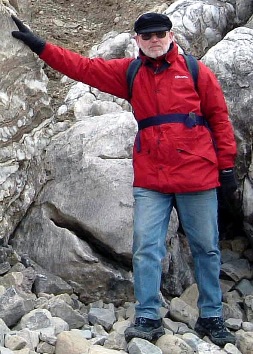
Geoffrey Dearn makes a case for real specimens in his quest to see the past brought back to life in Exhibition Road and museums of geology everywhere
Geoscientist 21.04 May 2011
Many years ago, while I was still at school, I took great pleasure in Saturday afternoon visits to South Kensington’s Museum of Practical Geology. It was a short journey on the District Line from Wimbledon and just a brief walk through the tunnel from the Underground station to the Museum. As time went by I took to cycling there, threading my way through the streets of Battersea and Chelsea and feasting on a plate of chips at Joe Lyons. Next door was the Natural History Museum, where I would take fossils for identification to the Palaeontology Department.
My favourite hunting grounds for these were the disused chalk quarries along the North Downs between Box Hill and Reigate. In those days my sole guides were
British Fossils by Duncan Forbes and
The Observer’s Book of British Geology, affordable even on the limited pocket-money of the day. From time to time I had to borrow a copy of Wood’s
Invertebrate Palaeontology from a school friend; at three guineas a copy of my own was beyond my reach. In time, I acquired B. Webster Smith’s
The World in the Past, bought for me during a summer holiday in Bognor Regis. Most of all, I treasured the
British Regional Handbook on The Wealden District.
At this time it was still possible to visit the Geological Museum and see a display of specimens, photographs and maps for each of the regions so well described in the published guides. Sadly, this is no longer true. The Museum of Practical Geology, which had graced Exhibition Road since its move from Jermyn Street in 1935, has for some years now been absorbed into the Natural History Museum, itself an architectural masterpiece that still retains an excellent minerals and meteorites room.
The area that once housed regional geology is now a poor reflection of its noble past; information displays and dioramas long gone, the bookshop replaced by a souvenir stall. The last edition of the British Regional Geology of the Wealden District that so fired my imagination all those years ago was published in 1965, and is now only available as a print-on-demand digital reprint.
Is it now too late to reclaim learning from popular entertainment? We can of course visit the Sedgwick Museum of Earth Science in Cambridge or the Oxford University Museum of Natural History, excellent places in their own right but the unique display of regional material in Exhibition Road seems to have no counterpart today. Is it too much to ask for the Earth Science section of the Natural History Museum to be restored to its former glory as a centre of education to inspire the next generation, as it was for me all those decades ago?